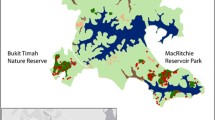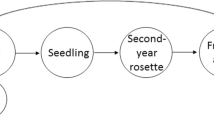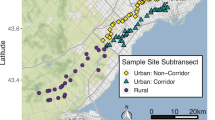Abstract
The spread of alien plant species is a critical ecological event worldwide, but the forces that control this spread are not well documented. Alien plant species are well known to disrupt ecological services of native ecosystems, change the composition of native habitats, and often lead to the extirpation of native flora and fauna. Here, we report on life history patterns of plant species with rapidly spreading and declining ranges in North America’s major urban region. We tested for differences in life history traits between the 466 native and alien woody flora of the New York metropolitan area. We also examined the relationship between life history traits and change in distribution in the New York metropolitan area between 1900 and 2000. Native and alien species of the New York metropolitan area differ with respect to pollination vector and breeding system. However, pollination vector and breeding system are not associated with success, defined here as increasing range spread in the urban environment; instead, fruit type (dispersal), life form and origin are important determinants of success. Alien species that are deciduous trees, shrubs or vines with fleshy fruit are the most successful in increasing their distribution in this urban landscape. Newly introduced species with these characteristics are expected to have a better chance at establishing in similar urban landscapes and should be targets for intensive management. The ability to predict which alien species will become invasive is also a valuable tool for the prevention of invasions by newly introduced plant species.
Similar content being viewed by others
References
Andrle RF, Carroll JR (1988) The atlas of breeding birds in New York state. Cornell University Press, Ithaca, 550 pp
Bartuszevige AM, Gorchov DL (2006) Avian seed dispersal of an invasive shrub. Biological Invasions Online First. Retrieved online from http://springerlink.metapress.com/(tkog5b45vgdaia3ub53gbdqm)/app/home/contribution.asp?referrer=parent&backto=issue,46,55;journal,1,32;linkingpublicationresults,1:103794,1 on 30 July 2006
Bawa KS (1980) Evolution of dioecy in flowering plants. Ann Rev Ecol Syst 11:15–39
Briggs D, Walters SM (1997) Plant variation and evolution, (3rd edn). Cambridge University press, Cambridge, UK, 512 pp
Clark JS, Silman M, Kern R, Macklin E, Hille Ris Lambers J (1999) Seed dispersal near and far: patterns across temperate and tropical forests. Ecology 80:1475–1494
Clemants SE, Moore G (2003) Patterns of species diversity in eight Northeastern United States cities. Urban Habitats 1:4–16. Retrieved from http://www.urbanhabitats.org/v01n01/speciesdiversity_full.html on 15 November 2005
Clemants SE, Moore G (2005) The changing flora of the New York metropolitan region. Urban Habitats 3:192–210. Retrieved from http://www.urbanhabitats.org/v03n01/newyork_abs.html on 27 December 2005
Côté SD, Rooney TP, Tremblay JP, Dussault C, Waller DM (2004) Ecological impacts of deer overabundance. Ann Rev Ecol Evol Syst 35:113–147
Craul PJ (1994) Urban soils: an overview and their future. In: Watson GW, Neely D (eds) The landscape below ground. International Society of Arboriculture, Savoy, IL, pp 115–125
Crawley MJ, Harvey PH, Purvis A (1996) Comparative ecology of the native and alien floras of the British Isles. Philos Trans R Soc B 351:1251–1259
Crawley MJ, Harvey PJ, Purvis A (1997) Comparative ecology of native and alien floras of the British Isles. In: Silvertown J, Franco M, Harper JL (eds) Plant life histories: ecology, phylogeny and evolution. Cambridge University Press, Cambridge, pp 36–53
Dirr MA (1983) Manual of woody landscape plants: ornamental characteristics, culture, propagation and uses. Stipes Publishing Company, Champaign, IL, 828 pp
Fernald ML (1950) Gray’s manual of botany, 8th edn. American Book Company, New York, 1632 pp
Gilbert OL (1989) The ecology of urban habitats. Chapman and Hall, New York, 352 pp
Gleason HA, Cronquist A (1991) Manual of vascular plants of northeastern United states and adjacent Canada, 2nd edn. New York Botanical Garden, New York, 910 pp
Hobbs F, Stoops N (2002) Demographic trends in the 20th century. US census bureau, census 2000 special reports, series CENSR-4, US Government Printing Office, Washington, DC, 222 pp
Hodkinson DJ, Thompson K (1997) Plant dispersal: the role of man. J Appl Ecol 34:1484–1496
Hollis JM (1991) The classification of soils in urban areas. In: Bullock P, Gregory PJ (eds) Soils in the urban environment. Blackwell Scientific, Oxford, 5–27 pp
Hough RB (1947) Handbook of the trees of the northern states and Canada east of the rocky mountains. Macmillan Company, New York, 470 pp
Johnson WC, Webb T (1989) The role of blue jays (Cyanocitta cristata L) in the postglacial dispersal of fagaceous trees in eastern North America. J Biogeogr 16:561–571
Keane RM, Crawley MJ (2002) Exotic plant invasions and the enemy release hypothesis. Trends Ecol Evol 17:164–170
Kelly C (1996) Identifying plant functional types using floristic data bases: ecological correlates of plant range size. J Vegetation Sci 7:417–424
Kelly C, Woodward FI (1996) Ecological correlates of plant range size: taxonomies and phylogenies in the study of plant commonness and rarity in Great Britain. Philos Trans R Soc B 351:1261–1269
Kowarik I (1990) Some responses of flora and vegetation to urbanization in central Europe. In: Sukopp S, Hejný S, Kowarik I (eds) Urban ecology: plants and plant communities in urban environments. SPB Academic Publishing, The Hague, 45–74 pp
Kunin WE, Shmida A (1997) Plant reproductive traits as a function of local, regional, and global abundance. Conserv Biol 11:183–192
Lockwood JL, Cassey P, Blackburn T (2005) The role of propagule pressure in explaining species invasions. Trends Ecol Evol 20:223–228
Mack RN (2003) Phylogenetic constraint, absent life forms, and preadapted alien plants: a prescription for biological invasions. Int J Plant Sci 164:S185–S196
Mack RN, Barrett SCH, deFur PL, MacDonald WL, Madden LV, Marshall DS, McCullough DG, McEvoy PB, Nyrop JP, Reichard SH, Rice KJ, Tolin SA (2002) Predicting invasions of nonindigenous plants and plant pests. National Academy Press, Washington, DC, 194 pp
McKinney ML, Lockwood JL (1999) Biotic homogenization: a few winners replacing many losers in the next mass extinction. Trends Ecol Evol 14:450–453
Moore G, Steward A, Clemants S, Glenn S, Ma J (2003) An overview of the New York metropolitan flora project. Urban Habitats 1:17–24. Retrieved from http://www.urbanhabitats.org/v01n01/nymf_full.html on 15 March 2004
Myers JH, Bazely DR (2003) Ecology and control of introduced plants. Cambridge University Press, Cambridge, 313 pp
Preston CD, Telfer MG, Arnold HR, Carey PD, Cooper JM, Dines TD, Hill MO, Pearman DA, Roy DB, Smart SM (2002) The changing flora of the UK. DEFRA, London, 35 pp
Pyšek P (1998) Alien and native species in Central European urban floras: a quantitative comparison. J Biogeogr 25:155–163
Rehder A (1940) Manual of cultivated trees and shrubs. The Macmillan Company, New York, 996 pp
Reichard SH (1997) Prevention of invasive plant introductions on national and local levels. In: Luken JO, Theiret JW (eds) Assessment and management of plant invasions. Springer-Verlag, New York, 215–227 pp
Reichard SH, Hamilton CW (1997) Predicting invasions of woody plants introduced into North America. Conserv Biol 11:193–203
Rejmánek M (1996) A theory of seed plant invasiveness: the first sketch. Biol Conserv 78:171–181
Rejmánek M, Richardson DM (1996) What attributes make some plant species more invasive? Ecology 77:1665–1661
Robinson GR, Handel SN (1993) Forest restoration on a closed landfill: rapid addition of new species by bird dispersal. Conserv Biol 7:271–278
Robinson GR, Yurlina ME, Handel SN (1994) A century of change in the Staten Island flora: Ecological correlates of species losses and invasions. J Torrey Bot Soc 121:119–129
Rouget M, Richardson DM (2003) Inferring process from pattern in plant invasions: a semimechanistic model incorporating propagule pressure and environmental factors. Am Nat 162:713–724
Telfer MG, Preston CD, Rothery P (2002) A general method for measuring relative change in range size from biological atlas data. Biol Conserv 107:99–109
Thompson K, Hodgson JG, Rich TCG (1995) Native and alien invasive plants: more of the same? Ecography 18:390–402
Vilà M, Maron JL, Marco L (2005) Evidence for the enemy release hypothesis in Hypericum perforatum. Oecologia 142:474–479
Williamson MH (1996) Biological invasions. Chapman and Hall, London, 244 pp
Williamson MH, Fitter A (1996) The characters of successful invaders. Biol Conserv 78:163–170
Yampolsky E, Yampolsky H (1922) Distribution of sex forms in the phanerogamic flora. Biblioth Genet 3:1–62
Acknowledgements
The authors would like to thank Dr. Gerry Moore for identification of pollination vectors and Dr. Peter Morin and Dr. Peter Smouse for statistics guidance. We also thank James Quinn for guidance on life history categories and Niall Dunne and two anonymous reviewers for their manuscript comments. We thank the funding agencies of the Brooklyn Botanic Garden’s NYMF project for supporting the development of the NYMF database. The Center for Urban Restoration Ecology supplied facilities for this analysis.
Author information
Authors and Affiliations
Corresponding author
Rights and permissions
About this article
Cite this article
Aronson, M.F.J., Handel, S.N. & Clemants, S.E. Fruit type, life form and origin determine the success of woody plant invaders in an urban landscape. Biol Invasions 9, 465–475 (2007). https://doi.org/10.1007/s10530-006-9053-1
Received:
Accepted:
Published:
Issue Date:
DOI: https://doi.org/10.1007/s10530-006-9053-1




